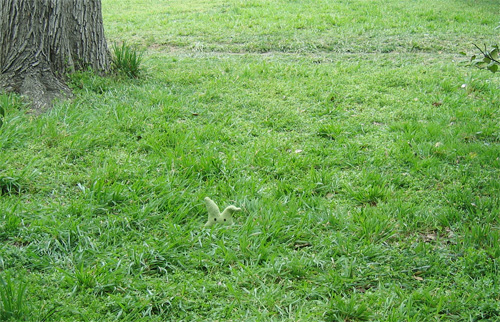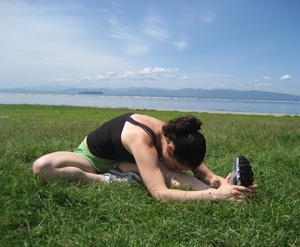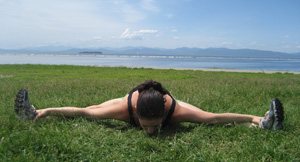
Day 1
Progression to one-rep max
The objective of this workout is to build pure strength in one of the most effective total body lifts, the deadlift. To accomplish this, we have Jason work his way up to his one-rep max (1RM) - the heaviest weight he can lift once. Before he begins, though, he completes a two-part warm-up session.

Warm-up (part 1): Rowing.
For this, Jason completes 10 minutes on the rowing machine at a pace that's less than 20 strokes per minute. (Jason's distance: 2274 metres.)
Warm-up (part 2): Pyramid Circuit.
Directions: do the following three exercises as a circuit, performing one set of each in succession without rest. Use a "pyramid repetition structure" to the workout. Here's how: in your first round through the circuit, do one repetition of each movement. In each subsequent round, perform an additional rep. So you'll do two reps of each exercise in round two, three reps in round three, and so on. Once you've completed five rounds, continue on, but reduce the reps you complete each round by one. So you'll do four reps in round six, three reps in round seven, and so on, until you've worked your way back down to one rep. At this point, your warm-up is complete.
1. Push-ups2. Ring chin-ups
These are classic chin-ups, but Jason uses gymnastic rings instead of the bar, and performs each rep as quickly as possible while maintaining control and a full range of motion.
3. Bodyweight Squats
Workout: this involves just one exercise, the deadlift. Jason starts with a light weight - about 35 per cent of the amount of his 1RM - and then slowly starts adding weight and reducing reps. As the weight becomes closer to his 1RM - which, for Jason, is more than twice his bodyweight - his rest between sets increases to three minutes. This allows for almost complete recovery between lifts. Remember, these are the weights that Jason uses. They should be determined based on individual ability.
Reps x weight x rest10 x 60kg - 1 minute
5 x 85kg - 2 minutes
3 x100kg - 3 minutes
2 x 130kg - 3 minutes
1 x 150kg - 3 minutes
1 x 155kg - 3 minutes
1 x 160kg - 3 minutes
1 x 162.5kg - 3 minutes
1 x 165kg - 3 minutes
Cool-down: 10 minutes on the trampoline. Jason uses a full-size gymnastic trampoline for 10 minutes of freestyle aerial work. Jason has an Olympic diving background, so he's doing fairly advanced movements here. In addition to fine-tuning motor skills, the trampoline is supposed to be good for your lymphatic system and flushing toxins from your cells.

Day 2
Functional Circuit
This workout is designed to be metabolically demanding, training the entire body with exercises that work multiple muscle groups.
Warm-up (part 1): Rowing.
Jason completes 10 minutes on the rowing machine at less than 20 strokes per minute. (Jason's distance: 2238m.)
Warm-up (part 2): Static Hold Circuit.
Directions: do these four exercises as a circuit. For each exercise, you'll hold a specific position for 30 seconds, then have 10 seconds to change stations, before starting the next exercise. Do four rounds.
1. Ring Dip HoldHold yourself in the top position of a dip for the prescribed amount of time. Like the ring chin-up, Jason performs this using gymnast rings instead of a dip station with parallel bars.
2. Kettlebell Farmer Hold
Grab a pair of heavy kettlebells (dumbbells will work in a pinch) and let them hang at arm's length at your sides.
3. L-sit on Parallettes or Dip Bars
Jason uses parallettes to perform this exercise, but the L-sit can also be done on a dip station that has parallel bars. (See these articles for a description of this device, how you can make your own, and photos and a description of how to perform the hold.)
4. Bodyweight Squat Hold
Lower yourself to the bottom position of a squat with your thighs parallel to the ground and hold.
Workout: this routine, called the "Big Five 55 Workout", comes compliments of strength coach Dan John.
Here, Jason performs a circuit of five exercises, which he does a total of 10 times.
There is no prescribed rest and ideally you move continuously from one exercise to the next while keeping the sets unbroken. Focus on going as fast as possible while maintaining form, full range of motion and control. The weights should be light enough to allow this.
You can run the stopwatch and race through this workout, but for better results and quality movement you should simply try to keep the momentum and flow through the exercises continuous. Jason starts with 10 reps of each movement, and each time through, reduces the reps by one. So he does 10 reps of all exercises in the first round, nine in the second, eight in the third, and so on, until he's doing just one rep in each set. The result is that he completes a total of 55 reps of each exercise. Again, the weights below are the amount Jason used in this particular week.
1. Front Squat (45kg)2. Chin-ups
3. Decline Parrallette Push-ups
Directions: hands on the parrallettes, feet on a box so that they are about 30 centimetres higher than your hands. Do the prescribed number of push-ups. Typically, because you're elevated on the parrallettes you can go much deeper in the bottom position and really push the range of motion, although this is dependent on shoulder flexibility.
4. Power Cleans
5. Knees to Elbows
Directions: hanging from a chin-up bar or from the rings at the half-cocked positon (elbows at a right angle), raise your knees until they touch your elbows. Lower them back down in one controlled movement so you don't swing.
Day 3
Interval Work
This session is performed on a Concept 2 rower.
Warm-up: Rowing.
Jason completes 10 minutes on the rowing machine at less than 20 strokes per minute. (Jason's distance: 2102m.)
Workout: to mimic Jason's interval workout, you'll do six intervals of 500m.
Between each 500m "sprint" engage in active rest for three minutes. For this, you can get off the rower and grab a drink of water, but you must continue moving around.
Here's a look at Jason's times for reference:- Sprint 1: 1:40.1
- Sprint 2: 1:39.7
- Sprint 3: 1:43.9
- Sprint 4: 1:41.6
- Sprint 5: 1:38.7
- Sprint 6: 1:50.3
Day 4
Set Work
Here, Jason focuses on front squats, one of the best strengthening and total body conditioning exercises there is.
Warm-up (part 1): Rowing.
Jason completes 10 minutes on the rowing machine at less than 20 strokes per minute. (Jason's distance: 2095m.)
Warm-up (part 2): Jason does 20 reps of bodyweight squats before moving on to the primary portion of the workout.
Workout: five sets of five reps of the front squat. In this workout, Jason used a load that was 105 per cent of his bodyweight.
Jason's Front Squat Workout (Reps x weight x rest)5 x 80kg - 90 seconds
5 x 80kg - 90 seconds
5 x 80kg - 90 seconds
5 x 80kg - 90 seconds
5 x 80kg - 90 seconds
Cool-down: Jason does 200 reps of the push-up, but he performs this workout using a "ladder" routine. We do this as partnered ladders of 1-5, so 13 ladders plus an extra 5 reps at the end. I do a push-up, he does a push-up, I do two, he does two, I do three, he does three, I do four, he does four, I do five, he does five. We've now each done 15 push-ups and we immediately repeat the process starting at one again.
We do these quickly, with the only rest being the time it takes for each of us to do our push-ups. If you wanted to do this alone, you could do one push-up and count "1 one thousand", do two push-ups and count "1 one thousand, 2 one thousand", etc. This approach allows you to do a large volume of quality work (with small sets there is no reason the push-ups aren't perfect and done explosively) without much, if any, residual muscle soreness. We also use this approach with chin-ups and knees to elbows. Not many folks finish their workout with 200 perfect chin-ups, but this approach makes it doable.

Day 5
Cumulative Movements
This workout is designed to be metabolically demanding, training the entire body with exercises that work multiple muscle groups. The Cumulative Movement workout consists of only one trip through, as opposed to a circuit workout in which you repeatedly cycle back through the same movements.
Warm-up (part 1): Rowing.
Jason completes 10 minutes on the rowing machine at less than 20 strokes per minute. (Jason's distance: 2149m.)
Warm-up (part 1): The Bear Crawl and Crab Walk.
Alternate between the bear crawl for a distance of 15m and the crab walk for 15m. Repeat until you've done five 15m increments of each.
Workout: one round through a series of exercises.
Directions: do one set of each movement, completing all of the prescribed number of reps before moving on to the next exercise. Perform each exercise as quickly as possible while maintaining proper form and full range of motion. The stopwatch is running on this one, so try to get through it as quickly as possible by minimising rest.'''
Jason's Circuit Workout (Exercise x Reps x Weight)7m Fat Rope Climbs x 5 x Body
Front Squats x 5 x 85kg
Ball Slams x 5 x 12.5kg
15m Rope Pulls x 10 x 40kg
Bench Press x 10 x 80kg
Ball Slams x 10 x 12.5kg
Chin-ups x 15 x Body
Dips x 15 x Body
Ball Slams x 15 x 10kg
Resisted Fat Rope Pulls x 20 (no weights)
Smashes x 20 (no weights)
Jason's Time: 23:53
Day 6
Contextual Effort
This can be any activity or sport that you enjoy doing. If this is of significant duration and intensity it should be considered as part of your training. In Jason's case, the goal was to get outside and maintain an activity non-stop for over an hour to build some endurance (training the aerobic energy pathway).
Workout: one-hour-plus mountain trail run. Jason's time: 73 minutes.
Day 7
Res
t
t









